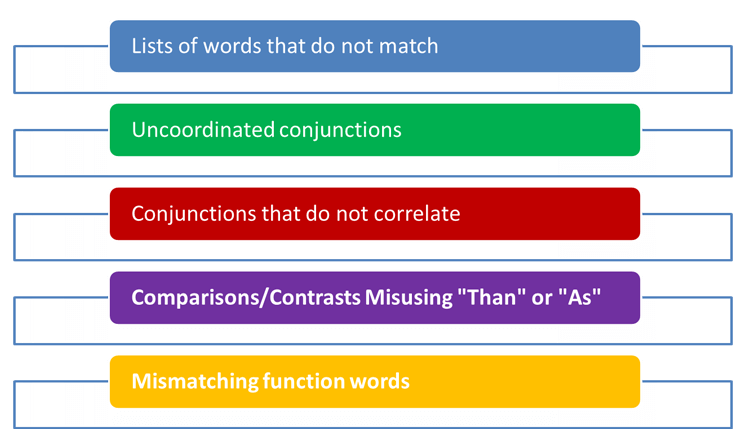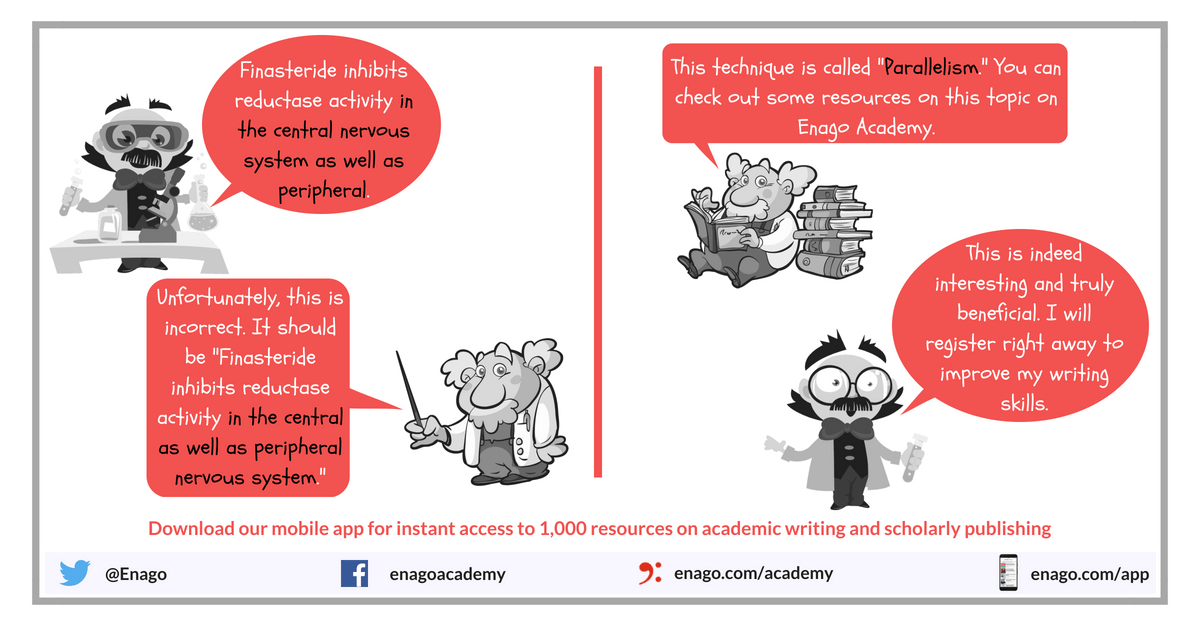How to Avoid Faulty Parallelism in Academic Writing

The use of components in a sentence that is grammatically the same or similar in their construction, sound, meaning, or meter is called as parallelism. As an academic writer, it is imperative to ensure that elements such as prepositions, words, and tenses agree with one another within sentences. When they do not, this is called faulty parallelism, and this can be the bane of even the most experienced writer. Often, parallel structures can be very subtle, so it is easy to slip up when it comes to identifying faulty parallelism. In this article, we will talk about what faulty parallelism is and the main types of errors associated with it. Parallelism errors are rather common in sentences containing a series, lists, or comparisons. Parallel structures help in ensuring clarity/readability, an economy of expression, and equality through logical connection within and between sentences. It also ensures that readers are able to grasp the right meaning of sentences, as a consequence of clarity.
What is Faulty Parallelism?
Faulty parallelism occurs when the items in the series of a sentence do not have the same grammatical structure.
Faulty Parallelism Example: I like to spend my winter holiday skating, skiing, and I also enjoy snowboarding.
Correcting Faulty Parallelism: I like to spend my winter holiday skating, skiing and snowboarding.
What are the Types of Faulty Parallelism?
There are five main types of faulty parallelism, as shown in the diagram. Let us discuss each one, with suitable examples.
 Lists of Words That Do Not Match
Lists of Words That Do Not Match
Explanation: Whenever you make a list or a series of two or more things, be sure to check for this type of faulty parallelism.
Incorrect sentence: Strategy for developing speaking skills includes using minimal response, how to recognize scripts and using language to discuss language.
Correct sentence: Strategy for developing speaking skills includes using minimal response, recognizing scripts and using language to discuss language.
In lists, you can also make the following type of error:
Incorrect sentence: John went on an Asia-Pacific trip to explore culture and heritage in Thailand, Japan, in Cambodia, and Indonesia.
Correct sentence: John went on an Asia-Pacific trip to explore culture and heritage in Thailand, Japan, Cambodia, and Indonesia.
Uncoordinated Conjunctions
Explanation: Conjunctions are used to connect parts of a sentence. Their proper use helps to create a sentence flow, ensuring graceful, clear, and elegant sentences. However, when these conjunctions are uncoordinated or do not match, it results in faulty parallelism.
Incorrect sentence: Emma’s research highlights the importance of cell membrane and helps in improving drug uptake in the cell.
Correct sentence: Emma’s research highlights the importance of cell membrane and improves drug uptake in the cell.
Conjunctions That Do Not Correlate
Explanation: Correlating conjunctions are linked to each other in a specific manner. They must correlate for the sentence to be grammatically correct. If the first part of the sentence is A and the second is B, the following constructions may work:
- Either A or B
- Neither A nor B
- Both A and B
- Not only A but also B
- Whether A or B
Incorrect sentence: The economist not only broke the code of honor but also was imparting false information to the committee.
Correct sentence: The economist not only broke the code of honor but also imparted false information to the committee.

Comparisons/Contrasts Misusing “Than” or “As”
Explanation: This can be seen when using phrases such as “more than,” “as well as,” or “as much as” to compare two things. This is a very subtle kind of faulty parallelism that is easy to miss.
Incorrect sentence: Finasteride inhibits the 5α-reductase activity in the central nervous system as well as peripheral.
Correct sentence: Finasteride inhibits the 5α-reductase activity in the central as well as the peripheral nervous system.
Mismatching Function Words
Explanation: These words get their name because they serve functions. They ensure that the sentence moves and operates correctly. Using incorrect function words can cause a sentence to stop working properly, causing a faulty parallel construction. Some function words are prepositions, articles, and the infinitive.
Incorrect sentence: Some readers believe that Tolstoy is too verbose of a writer and his book War and Peace is not a great masterpiece.
(The first part of the sentence uses the introductory word “that” before “Tolstoy.” Therefore, the second subject, “his book” needs to be introduced by this same Function Word.)
Correct sentence: Some readers believe that Tolstoy is too verbose of a writer and that his book War and Peace is not a great masterpiece.
So, now you know just some of the sentence constructions that can result in faulty parallelism. Do keep these in mind when writing so that you avoid making such errors.
How to Avoid Faulty Parallelism?
- Words, phrases, and clauses joined by a coordinating conjunction (and, but, or, nor, for, so, yet), correlative conjunction (not only… but also, both… and, either… or, neither… nor), and comparative expression (as much as, more than, less than) must have parallel grammatical construction.
- Words, phrases, and clauses in a series must have parallel grammatical construction.
- Phrases or items in a bulleted list must have parallel grammatical form.
References:
- Writing Center, Walden University. Grammarly: Faulty Parallelism. Retrieved from http://academicguides.waldenu.edu/writingcenter/grammarly/faultyparallelism
- Writing Center, Walden University. Grammar: Parallel Construction. Retrieved from http://academicguides.waldenu.edu/writingcenter/grammar/parallelconstruction
- Jerry Plotnick, University College Writing Centre. Faulty Parallelism. Retrieved from http://advice.writing.utoronto.ca/revising/faulty-parallelism/






Quite educative